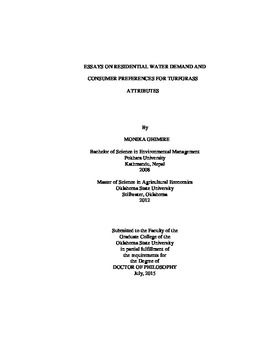| dc.contributor.advisor | Boyer, Tracy Ann | |
| dc.contributor.author | Ghimire, Monika | |
| dc.date.accessioned | 2016-09-29T18:40:12Z | |
| dc.date.available | 2016-09-29T18:40:12Z | |
| dc.date.issued | 2015-07 | |
| dc.identifier.uri | https://hdl.handle.net/11244/45258 | |
| dc.description.abstract | The first essay determined the residential water demand and the factors affecting water demand for different periods (pre-drought vs. during-drought and summer vs. winter) in Oklahoma City area. Individual household water consumption, household age, household value, parcel size, water price, and weather variables from July 2009 through December 2012 for Oklahoma City area were used. A two-stage least-squares estimation with an instrumental variable was used to develop a water demand model. Results indicated that water demand was inelastic to water price except for high consumption period. Parcel size, income, and temperature were positively related to water demand, while rainfall, household age, and water price negatively influenced water demand. | |
| dc.description.abstract | The second essay determined the consumers' preferences and willingness to pay for different turfgrass attributes while assessing the heterogeneity in preferences for attributes of turfgrass in five states (Florida, Georgia, Oklahoma, North Carolina, and Texas) of the U.S. Results based on a survey of 1,179 household consumers indicated that there was significant preference heterogeneity for the preferences of turfgrass attributes. The household turf consumers were clustered in two broad classes; "willing household consumer" and "reluctant household consumer". Willing household consumers were characterized by high income and hobbyist, while reluctant household consumers were characterized by people more than 45 years. Results also indicated that willing household consumers were most likely to pay more for improved turfgrass attribute than were reluctant household consumers. | |
| dc.description.abstract | The third essay determined the preference shares for the turfgrass attributes and compared and contrasted the results from the discrete choice experiment (DCE) and best-worst method (BWM). An online survey was conducted and a mixed logit model was used to determine the homeowners' relative preferences for turfgrass attributes. The results indicated that the most preferred attribute using either of the methods was low maintenance cost. Although the relative importance by the DCE and the BWM were statistically different, both methods yielded a similar preference ordering for low maintenance, drought tolerant, and saline tolerant turf, but different ordering for shade tolerant and low purchase price turf. | |
| dc.format | application/pdf | |
| dc.language | en_US | |
| dc.rights | Copyright is held by the author who has granted the Oklahoma State University Library the non-exclusive right to share this material in its institutional repository. Contact Digital Library Services at lib-dls@okstate.edu or 405-744-9161 for the permission policy on the use, reproduction or distribution of this material. | |
| dc.title | Essays on residential water demand and consumer preferences for turfgrass attributes | |
| dc.contributor.committeeMember | Chung, Chanjin | |
| dc.contributor.committeeMember | Lusk, Jayson | |
| dc.contributor.committeeMember | Moss, Justin Quetone | |
| osu.filename | Ghimire_okstate_0664D_14216.pdf | |
| osu.accesstype | Open Access | |
| dc.type.genre | Dissertation | |
| dc.type.material | Text | |
| thesis.degree.discipline | Agricultural Economics | |
| thesis.degree.grantor | Oklahoma State University | |
